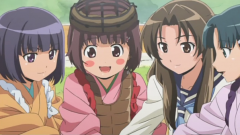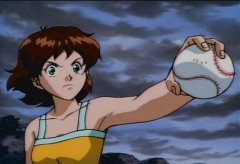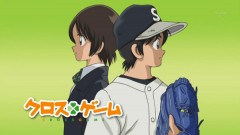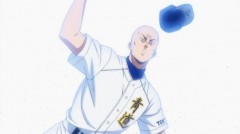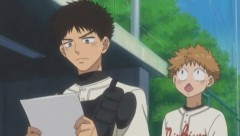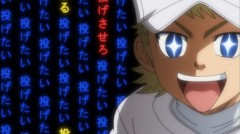October 6, 2015 at 05:00 PM
Hanshin Kōshien Stadium
It’s October! Oktoberfest beers have already been on the shelves for a few months in some cases (don’t they know when to stop? It’s madness!!), but more importantly, the Major League Baseball playoffs have begun. My team, Chicago’s south side White Sox, fell pretty quickly out of the gate after the All Star break—not that they were doing that well to begin with—but there’s 10 teams at the onset of the playoffs that could theoretically make it to the World Series. Win seven or eight games (depending on if you’re a wild card team or not) and you get to play on baseball’s greatest stage.
I don’t really have a prediction for the World Series, and that’s not really why I’m here typing these letters. I’m here to talk about the boys and girls on the mound. The ones who’ve fought with their blood, sweat, and tears to get where they are and the ones who’ve risked their arms to stand on Japan’s greatest stage: The Koushien. Some of these characters have, some of them haven’t, and maybe some of them will. But if the Cy Young award is telling at all, it isn’t only wins and team achievements that get you to the top spot in pitching. It’s being a great pitcher. And these five young men (and women!) are great pitchers. Specifically here, I’m talking about batteries, so great pitcher / catcher combinations.
But before I get into the list proper…a few pitcher / catchers who didn’t make the list:
I mean, Ace of the Diamond, for all its worth, is about pitchers. And it has given us a wide range of pitchers to choose from. I included one and he is from Seidou, so I won’t mention the other Seidou pitchers just yet, but they’re all good. Others from that show are Yakushi’s Sanada, who has a nasty cutter; the current arc’s Wakabayashi that seems to use every trick in his book and some from other’s books; Ugumori’s Umemiya; Akikawa’s You Shunshin; Teitou’s Mukai Taiyo; Sensen’s Maki Yousuke; and Tanba’s old buddy Manaka from Ichidaisan. Each have their strengths, each have their weaknesses, but a large reason why they’re off this list is because they’re not main characters. We just don’t see enough of them to get a good grasp on whether they’re truly great or just the ace of their high school team. But for an in depth look at pitching, check out Ace of the Diamond. It’s got it all; even a submarine pitcher for like five seconds!
Taisho Baseball Girls
The only other good battery I’ve seen (that I’ll mention for now) is the duo of Suzukawa Koume and Ogasawara Akiko. I actually give this duo a lot of credit for a multitude of reasons: They’re girls in 1925 Japan that don’t really have a coach and managed to learn a fastball from what coaching they had and a breaking ball from their own natural talent. I think, with a real coach, Akiko could grow into a much better pitcher than she became by the end of the series. Her “magic pitch,” as they call it, I think is a knuckleball, or a variation thereof. But even though they didn’t have a coach, they had societal discrimination against them, and they had no coach, they became great. That’s worth talking about.
There are only so many shows I’ve seen, and even fewer baseball shows. Out of the notable ones that I haven’t seen—or at least the ones I know of—are Major and One Outs. I don’t know if these are, or ever have been, streaming anywhere, which is a big reason why I haven’t watched it yet.
5. Hayakawa Ryo / Daidoji Mao
Princess Nine
At the onset of this piece’s conception, I was super happy because I knew I’d be able to talk about Princess Nine, at least a little bit. I’m glad that, even after I looked through the batteries, I was able to put these two on the list based on their merit rather than a perceived love for Princess Nine (though I do really love Princess Nine…).
These two are a bit unusual…Ryo holds a bit of a chip on her shoulder because her dad was kicked out of baseball for something he didn’t do. Mao was dragged into playing baseball by the team because they needed a catcher strong enough to catch Ryo’s pitches. Girls can be as strong as boys, yes, but it takes someone with some backbone to be able to catch pitches nearing 100 mph at the high school level, I’d wager among the boys as well. On one hand, they had the biggest girl be the only catcher who could catch Ryo’s pitch. But on the other hand, they had a bigger girl that wasn’t just the butt of the joke, and also moe in her own right.
But let’s talk about their merit as a battery. Ryo has a mean fastball. And by mean I mean MEAN. From all indications, it’s as good as a high school senior or even rookie pro level. The problem is that she doesn’t really have a breaking ball. It’s obvious she has great control, but it’s also obvious she isn’t going to get very far with only a fastball in any league. The catcher, while good, could use a lot of work too. Mao was placed there out of necessity, not because she liked the position. A better catcher and the addition of a breaking ball, and Ryo could easily be way higher.
4. Kitamura Kou / Akaishi Osamu
Cross Game
It’s hard to hate Mitsuru Adachi. He’s made three great baseball series in Touch, H2, and Cross Game. I actually was torn between Kou / Akaishi or Uesugi Tatsuya / Matsudaira Koutarou, but it became obvious once I gave it a little more thought. Tatsuya, for all his flaws, really only came into his own in the final episodes. That was the journey for him, and it was wonderful to behold, but he was always in Kazuya’s shadow. There’s nothing inherently wrong with this, but there’s also a lot of things Kou has going for them that Tatsuya doesn’t, necessarily.
Both don’t have a breaking ball though, which is always a huge minus. What’s with all these starting pitchers without breaking balls?? You can, and sometimes do, get by without a breaking ball. But as a starter, you need versatility. Plus your arm just isn’t going to hold up throwing only fastballs for an entire game.
But they’re really, REALLY good at throwing fastballs. They can do inside and outside with ease and it’s fast enough that no one can really get a handle on it until the second or third go around. The difference is teacher. Tatsuya and Kazuya learned at the same time, but Tatsuya was kind of cavalier about it. He was talented, for sure, and a 1-2 punch of Kazuya / Tatsuya would have made any team run. But Tatsuya joined the baseball game in high school, and late at that, because of his own lackadaisical attitude.
Kou, however, was taught by the best: his next door neighbor, childhood friend, tomboy, pitcher Tsukishima Aoba. Aoba is an even more amazing pitcher than Kou, but she’s a girl, so she can’t play in sanctioned games.
Now, I haven’t finished Cross Game quite yet, but I don’t think Kou is going to get much better than he is as of volume five of Viz’s release. At least I don’t think he will based on seeing all of Touch.
3. Tanba Koichiro / Miyuki Kazuya
Ace of the Diamond Episode 54
There’s so many pitchers I could choose from in Ace of the Diamond, as I listed above. There’s also a lot I could pick just from Seidou. Rising star, Sawamura Eijun, current staff ace Furuya Satoru, or solid-as-hell Kawakami Norifumi. But there’s really one way to go, at least there’s only one way to go based on where we are in the series right now.
Kawakami is mostly shown as the solid reliever, so I honestly don’t have enough of a sample size to judge whether he really is a good pitcher or not. He’s been trusted to close out so many games for Seidou, so I presume he is. For the purposes of my list, I didn’t even consider him. Furuya and Tanba, however, have a lot of episodes to sort through and see where their true strength lies. For me, Tanba is the only one that could push Sawamura off this spot in the list.
Furuya, as a baseball player, has his fastball. That’s his one consistently good pitch. And it’s an amazing fastball. By all indications, better than both Ryo and Kou. The problem is that his splitter and slider are barely shown. And his main weapon is obviously his fastball. He gets those other two pitches into “threat” level, and we’ll talk about him again. Until then, he’s an A+ reliever.
Sawamura is merely inconsistent. He has high up sides, but he hasn’t reached those yet. He lacks the kind of reliable control he’s going to need as fast as he throws and, most importantly, he lacks a reliable breaking ball. He was scouted for having a moving fastball, but it’s stopped moving since he got his form under control and started throwing the four-seam fastball. The fastball is still good and the cutter only works in the highest risk situations apparently. He has a changeup that doesn’t seem to work in real games yet and the full palm pitch that god knows what that is, but it works because it breaks like hell. But to make it, to be the ace that he wants to be, he needs to develop more. He needs that changeup to work 99 percent of the time and he could make that cutter a full time pitch. He’s a fastball pitcher for sure, but he gets outs from contact and placement, not speed.
Tanba, on the other hand, has an amazing fastball, an amazing curveball, and an amazing forkball. The problem is he lacked confidence basically until his third year. It doesn’t help that his entire class was considered a throwaway from the get go. But he developed, he worked hard to get where he was and, finally, in his third year, he developed a forkball that rounded out his repertoire and had the ability to be dominant.
Having said that, I believe in my heart of hearts that Sawamura has that talent to rise higher than Tanba, and will.
2. Mihashi Ren / Abe Takaya
Big Windup
I love Mihashi as a pitcher. This is really where I learned just how important a catcher can be to the pitcher and to the team. An ace in his / her own right will be able to recognize things on his / her own, but the catcher can lead in a different way. The catcher is the only position on the field that can see everything else on the field without having to stand awkwardly to do so. The catcher helps the pitcher decide what to throw. The catcher is the first one to control the ball after the pitcher—or at least that’s the ideal.
Before Abe Takaya, Mihashi Ren was nothing. After Abe, Mihashi is the ace of an upstart team with a lot of good players and a lot of luck. It was only the other pitcher—the only one on Mihashi’s junior high team—that recognized his skills as a pitcher. Everyone else wrote him off because the catcher wouldn’t work with him, because the catcher didn’t see the potential, because he easily gave up hits. That’s the difference a catcher can do.
Mihashi is a pitcher that’s all technique. He’s years ahead of where Sawamura is right now, but they’re very similar types. Both don’t have very much speed (though Sawamura has more), and Mihashi has the control and variety of pitches I’d like to see from the Sawamura of the future.
I can’t remember what’s in his repertoire, and I can’t find an easy list of it online, but I remember it was at least a fastball, a curveball, and I think a changeup. That’s an amazing list for someone who can paint every corner of the strike zone with ridiculous precision. That’s someone you want as your pitcher.
1. Narumiya Mei / Harada Masatoshi
Ace of the Diamond Episode 19
So I kind of hate Narumiya. Not as a player, mind you, as a character. And that’s not to say I hate his role in the story, because I think that’s very good as well. What I’m getting at here is that I dislike Narumiya man to man. He’s arrogant, but damn if he can’t pitch really, really well.
There’s a reason he’s at the top of my list. There’s a reason he bested Seidou at their best. There’s a reason why Inashiro is such a powerhouse right now. It’s all because of Narumiya. That’s hardly even an exaggeration too. He enlisted talented junior high students to join Inashiro with him and make a run at the Koushien.
The backbone of the team, though—the thing that keeps them going when they’re down—is Narumiya. He has a fastball that kills, a slider and forkball that complimented it well, and a new changeup that made him one of the nastiest pitchers ever to face. The two breaking balls were enough, but he added a changeup. A changeup! He showed it off early, so Seidou knew about it in episode 19, but that doesn’t make it easier to hit. Yuki, their best hitter at the time, still struggled against it. And he was the only dude Narumiya was trying against.
Yeah, Narumiya is a cocky asshole, but he’s also an amazing pitcher.
The changeup changed him. He went from well above average to undoubtedly the best. One of the teams that beat them used a pitching relay, like Seidou, during the game. That just means that every pitcher combined were off speed of the Inashiro batters enough to win. Narumiya was good enough to start the whole game.
So I love baseball. It’s eclipsing football as my favorite sport because I also love the ridiculous amount of statistics that are in baseball. Despite this, I don’t really get to watch many baseball games. I don’t have cable and my beloved White Sox are in a blackout zone where I live, so I don’t feel like paying for a service that might be blacked out.
I also know I’m like a super baseball novice and many of the things I said here, I might look back on and be like, “Really Kory from 2015? You said that?” But in sports anime, it isn’t about sabermetrics or being the best pitcher; it’s about being the best team and being the better team on that day during that game. For all these pitchers, those days sometimes came and sometimes didn’t. Baseball—and all sports—is a variety of variables that could mean the typical outcome happens or the upset occurs. That’s what’s so exciting about sports; you truly never know the outcome until the game starts being played.
Kory got the anime bug in the beginning of the anime boom with Dragonball Z, but really got into it around 2009 in college. Since then, his fandom has grown to unnecessary proportions. He likes arguing about several things, especially over the internet and sometimes on the Taiiku Podcast. Kory’s favorite shows include Touch, Revolutionary Girl Utena, Moribito, Chihayafuru, and a few more in between.
Kory Cerjak – who has written 555 posts on The Fandom Post.

